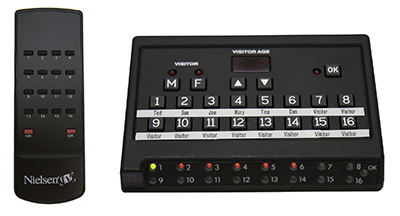Tracking Cross-Platform Viewing
Gary Arlen NEW YORK: Beyond NBC’s spectacular ratings for its broadcast and cable coverage of the Summer Olympics is the equally awesome data on how many viewers tuned into the Games via online and wireless devices. That huge viewership is prelude to the next plateau in the always contentious topic of measuring viewers in the cross-platform era.

For years, TiVo, Rentrak, BlueFin, comScore, Centris and other researchers have been crowing about their abilities to identify real—and real-time—viewership recently across platforms. Nielsen’s acquisition in July of Vizu, a San Francisco technology firm specializing in real-time ratings for online advertisers, escalates and expands the competitive measurement landscape.
Underlying all these efforts—including the recent assault on second-screen viewing measurement—are the needs of programmers and advertisers to use new “big data” capabilities to tailor their delivery to the latest whims of viewers who are watching on any platform. In the process, researchers are identifying emerging viewing patterns.
For example, Centris Marketing Services Senior Vice President John High said his company is beginning to see the migration to streaming in households that have a pay-TV subscription. Centris’ initial research finds that people are spending more time with online streaming, but he admitted that the industry still “needs a reliable process” to analyze how viewers “spend time in conjunction with other things they do.”
The Nielsen Co. is also trying to accelerate its multiplatform measurement process.
“We’re encouraging content providers and advertisers to add ‘tags’ to their video [when it is streamed online] so that we can measure it wherever viewers see it,” said Scott Brown, senior vice president, engineering and strategic relations at Nielsen. He said that the Vizu deal will let Nielsen integrate real-time reporting capabilities into its online ratings services through its Nielsen Cross- Platform Campaign Ratings and Brand Effect service, which includes TV ratings.
Brown also pointed out the complexity of the new on-demand environment, noting that, for example, commercials served during a VOD viewing may be different from the ones carried during the original telecast. Such changes go beyond the current “C3” standard, which tallies viewers who watch a show on their digital video recorders within three days after the original showing.
Second-screen viewing—which can include interactive ad responses on a tablet or smartphone coordinated with a TV commercial— further complicates the measurement process. Real-time ordering via the handheld device is itself a measure of success for advertisers, but programmers will want to know more about how the process affects the flow of viewers while watching the show.
“We assume that the second screen is going to become a more important factor,” Brown said.
HOW, NOT JUST WHAT, YOU WATCH
Cross-platform and multiplatform options become more important to programmers and advertisers when, as seen with the Olympics, substantial viewing is done away from the TV set.
For example, NBC says that its Olympics videocasts served more than 150 million video streams; of those, more than 65 million were live streams. The network estimates that NBCOlympics.com had more than 57 million visitors, who generated more than 1.9 billion page views across all platforms (not all of them video streams) during the games.
For the London games, usage averaged 111.4 live-streaming minutes per viewer on the Web and 94.3 live-streaming minutes per viewer on the mobile app, NBC says.

Nielsen People Meter Comcast Corp., majority owner of NBCUniversal, separately reported that among its subscribers, 1.5 million customers accessed about 25 million video streams online and via mobile devices during the Olympics. Matt Strauss, Comcast senior vice president of digital and emerging platforms, called it a “watershed event.”
“Our focus is now taking the success from the Olympics and taking it to fall TV and other kinds of programming, primarily sports, news and kids,” Strauss said an the interview with TV Technology sister publication Multichannel News.
Viewers’ embrace of nonlinear delivery underscores the networks’ and advertisers’ demand for reliable measurement tools. The data-based nature of on-demand viewing and cross-platform services is pulling more companies into the ratings mix.
In early August, a deal between Rentrak, the media measurement firm, and iTVX, a branded-entertainment analytics provider, demonstrated the value of special-purpose measurement. The companies teamed up to create a service that will let brands and programmers assess the impact when a TV show uses a brand in a story line or in a demonstration.
Separately, Harris Interactive, which has long focused on online behaviors, recently developed systems to evaluate the impact of interactive online video ads. It found, for example, that 37 percent of Facebook app users prefer pre-roll video ads compared to 63 percent who would rather initiate the video ad or see it as mid-roll during a natural break in the programming.
POSITIONING FOR THE METRICS MIASMA
Like many researchers, Centris has come up with its own lingo to describe audience segmentation in the multiplatform era.
“Cord Non-Converter” is Centris’ term for households that have never subscribed to pay-TV service and use OTT and/or over-the-air TV to see video content. Among that group (largely young/single viewers) Centris found, a lower-than-average use of live TV, which is falling fast.
This segment is rapidly increasing its reliance on streamed/downloaded content. Centris found that in late 2011, viewers in this category spent 22 percent of their video time watching streamed video; by early 2012, they devoted 28 percent of their time to such delivery, according to the self-reported data in the Centris study.
That share was less than the “cord cutters,” who without any cable/ satellite feed spent 41 percent of their viewing time online in early 2012, compared to the 6 percent online viewing time share in all TV households with an Internet connection.
Centris has also identified a seasonality factor in online viewing, similar to standard TV tune-in patterns.
“We were surprised; we thought it was more consistent,” said Centris’ High. “When we started this, online viewing was growing so fast. As it turns out, Internet viewing is the same as HUT [Home Using Television] levels.”
He acknowledged a “novelty effect” that surfaced early in Centris’ research: People who bought a Roku or similar Internet-TV access device or started using game console broadband connections to tune into Internet videos spent more time with online video for a while, until they found a way to integrate viewing into their standard usage patterns.
The challenge now is to integrate the various viewing access points, High says. Centris, which tracks viewing largely for multichannel video program distributors, has “had to bring in over-the-top and VOD” to get a more accurate way to measure the ways in which video is consumed, he explains.
comScore, which has focused on online analytics, represents another crossover-data processer approach. For example in comScore’s latest “top 10 online video properties” roster, two of the providers are offshoots of cable channels: Viacom Digital (whose websites include Comedy Central, MTV, Spike and TV Land) and Turner Digital (CNN, HLN, TBS, tru-TV and more).
comScore’s top 10 online video ad sites include Hulu and ESPN, both of which served “ads per viewer” (described as “frequency”) at rates far exceeding those of Google, the top provider by total video ads.
From all these and other measurement services, the competing avalanche of data—and interpretations—will remain both important and confusing for advertisers, carriers and content providers. But that won’t stop even more efforts to figure out a reliable way to tally the eyeballs and try to find out what viewers are actually doing as they roam across digital platforms.
Gary Arlen is president of Arlen Communications LLC, a media/telcom research firm. He can be reached atGaryArlen@columnist.com.
Get the TV Tech Newsletter
The professional video industry's #1 source for news, trends and product and tech information. Sign up below.
Gary Arlen, a contributor to Broadcasting & Cable, NextTV and TV Tech, is known for his visionary insights into the convergence of media + telecom + content + technology. His perspectives on public/tech policy, marketing and audience measurement have added to the value of his research and analyses of emerging interactive and broadband services. Gary was founder/editor/publisher of Interactivity Report, TeleServices Report and other influential newsletters; he was the long-time “curmudgeon” columnist for Multichannel News as well as a regular contributor to AdMap, Washington Technology and Telecommunications Reports; Gary writes regularly about trends and media/marketing for the Consumer Technology Association's i3 magazine plus several blogs.

